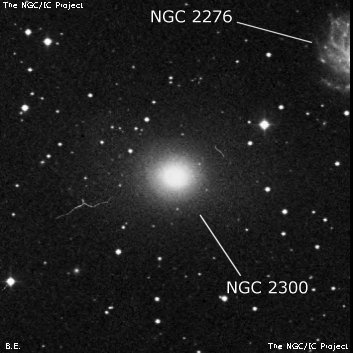
Alphonse Borrelly discovered NGC 2300 in 1871 or 1872 with a 7.2-inch comet-seeker at the Marseille Observatory. He noted "Nebula pretty bright, moderately extended, round; nucleus of 12-13 magnitude." His micrometric position (MNRAS, 32, 248) was accurate. Friedrich August Winnecke independently found the galaxy on 26 Jun 1876, as well as Wilhelm Tempel (list V-21) in 1877. NGC 2300 is the 4th closest to the pole in the NGC or IC.
200/250mm - 8" (1/1/84): moderately bright, small, bright core, slightly elongated.
300/350mm - 13.1" (1/18/85): fairly bright, bright core, small fainter halo. Forms a pair with NGC 2276 7' W. IC 455 is 11' SSE.
400/500mm - 18" (8/2/11): bright, moderately large, slightly elongated, ~1.5'x1.3' diameter. Sharply concentrated with a very bright core that increases steadily to the center. The halo fades out and increases with averted vision. Forms a striking pair with NGC 2276 just 6' NW. NGC 2300 and 2276 are the brightest in a group of galaxies near +85° declination which includes IC 455, IC 469, IC 512, UGC 3654, UGC 3670, UGC 4078, UGC 4348 and more.
18" (3/13/04): fairly bright, fairly small, irregularly round, 1.2' diameter. Well concentrated with a bright 25" core and a much fainter irregular halo. Forms a trio with NGC 2276 6' W and IC 455 11' SSE.
Notes by Steve Gottlieb